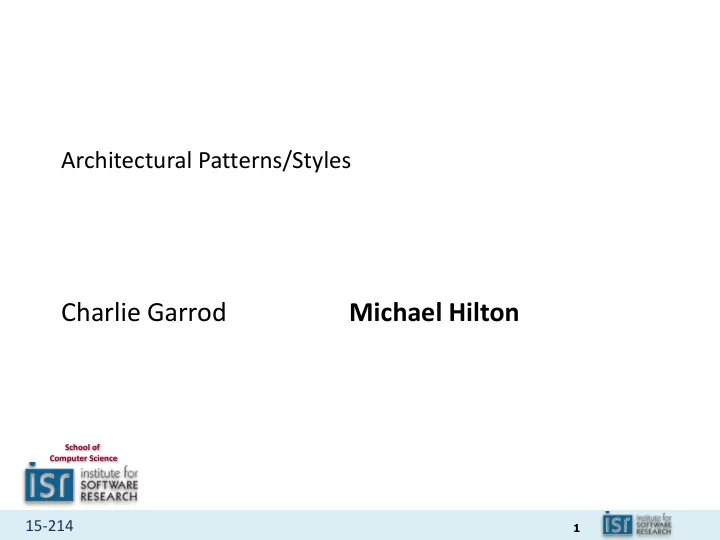

Architectural Patterns/Styles Charlie Garrod Michael Hilton School of Computer Science 15-214 1
Administrivia • Homework 6 checkpoint – Monday Dec 4 th • Final Exam Review: Dec 13 th , 2-4pm Wean 5409 • Final Exam: Dec 15 th , 5:30-8:30pm Wean 7500 15-214 2
Last Time: • Design Patterns 15-214 3
ARCHITECTURAL PATTERNS/STYLES 15-214 4
Design Patterns 15-214 5
Architectural Styles 15-214 6
Architectural Styles 15-214 7
Architectural Styles vs Design Patterns 15-214 8
Monolithic Application + Simple to start + Simple to deploy + Fast time to first feature - Difficult for new developers to come up to speed - Continuous deployment is difficult - Scaling can be difficult - Can devolve into “big ball of mud” 15-214 9
Layers 15-214 10
Layers • Context: – A large system that requires decomposition • Problem: – Low separation of concerns. – Parts of system are not interchangeable – Lack of grouped components hurts understandability and maintainability – Lack of boundaries makes tasking difficult • Solution: – Define layers of abstraction – Specify services between boundaries • Beware: – Antipattern: Sinkhole – Antipattern: Lasagna 15-214 11
Pipe and filter 15-214 12
Pipe and filter • Context: – Processing data stream • Problem: – Need to process or transform a stream of data – Non-adjacent steps don’t share information – Need to reuse certain steps in the process • Solution: – Each filter transforms the data, then moves it on to the next step • Beware: – Error Handling – Data transformation overhead 15-214 13
Blackboard 15-214 14
Blackboard • Context: – An immature domain where no closed approach is known to be feasible • Problem: – A complete search of solution space is not feasable – Multiple algorithms possible for different subtasks – Some algorithms work on the output of others – Uncertain data and aprox solutions are involved • Solution: – Independent programs working cooperatively on common data – Inspect and update data • Beware: – Difficult to test – Difficult establishing a good control strategy 15-214 15
Model-View-Controller 15-214 16
Model-View-Controller • Context: – Interactive applications with a flexible Human-Computer interface • Problem: – How to develop an application not dependent on interface – Need ability for application to support different interfaces – Allow simultaneous development • Solution: – Model – View – Controller division • Beware: – Code navigability – Increased complexity 15-214 17
Broker 15-214 18
Broker • Context: – Decoupled components interact through remote service invocations • Problem: – Scaling for large scale systems – Components should be decoupled and distributed • Solution: – Brokers mediate between clients and servers • Beware: – Less efficient – Lower fault tolerance 15-214 19
Microkernel 15-214 20
Microkernel • Context: – The development of several applications that use similar interfaces on same core • Problem: – Should cope with continuous hardware and software evolution – Platform should be portable, extensible and adaptable • Solution: – Encapsulate fundamental services of your application platform in a microkernel – Other functionality provided by internal servers • Beware: – Complexity of design and implementation 15-214 21
Event-driven architecture 15-214 22
Event-driven architecture • Context: – Building a loosely coupled, more responsive system • Problem: – Build a system that reacts to events in the world around it – Only have to decide what to do, not when to do it • Solution: – Event creators, managers, and consumers • Beware: – Security risks – Increased complexity 15-214 23
Peer-to-peer 15-214 24
Peer-to-peer • Context: – A system where each node has the same capabilities and responsibilities • Problem: – A situation where it is not feasible to know ahead of time which nodes will be servers – Large amounts of data need to be sent transmitted • Solution: – Decentralized computing – Highly robust in the face of node failure – Highly scalable • Beware: – No server to manage data – No always used for legal purposes 15-214 25
Service-oriented architecture 15-214 26
Service-oriented architecture • Context: – Services are provided to other components over a network • Problem: – Building a distributed system – Expose a service no objects • Solution: – Each service should: • Represent a business activity with a specific outcome • Be self-contained • A black-box for its consumers • May consist of underlying services • Beware: – High investment cost 15-214 27
Exercise: • Styles: • Application – Monolith – Online banking application – Layers – API for third party tools to get banking information – Pipe and Filter – Compiler – Blackboard – Optical Character recognition – MVC – VR content delivery system – Broker – VR game – Peer-to-peer – Insurance claim processing – Microkernel system – Event-driven – Service-oriented 15-214 28
Recommend
More recommend